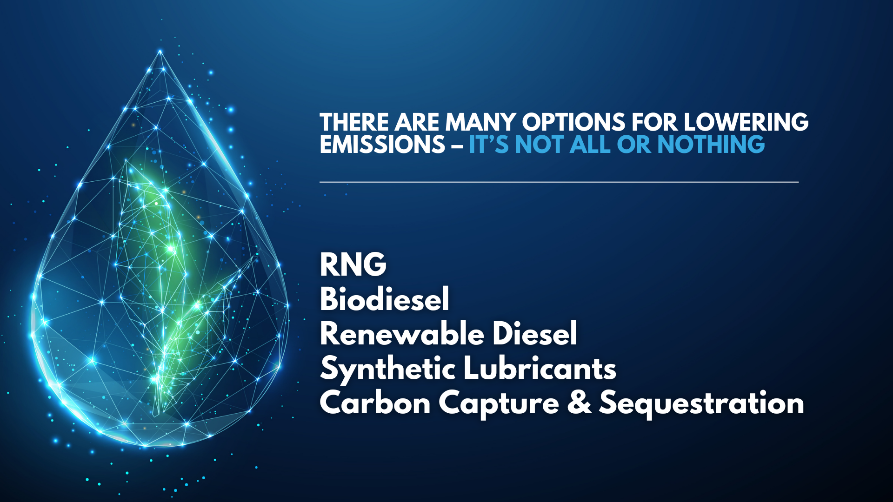
Energy Security and the Energy Transition: CEO Michael Mansfield, Sr. Shares Perspectives at the Federal Reserve Bank
Mansfield Energy CEO Michael Mansfield, Sr. was recently invited to speak at the Federal Reserve Bank of Richmond’s conference on Technology-Enabled Disruption. His remarks from the event are shared below.
As one of the largest fuel distributors in North America, Mansfield has the privilege of reviewing transportation energy trends with some of the largest fleets in North America. When we talk to our customers about their energy transition strategies for today and tomorrow, four topics arise:
- Are the energy sources clean and getting cleaner?
- Are energy sources affordable?
- Is the supply chain secure?
- Are the products commercially available now (and if not now, then when)?
As you’d expect, these questions and their answers are dynamic depending on world events, customer geography, governmental curtailment or incentives, evolving technologies, competing commodity markets and more. This is how Mansfield goes to market: we educate & provide options, enabling our customers to make their own informed decisions.
The Energy Transition & the Future of Fuel
While alternative energy sources (for transportation use in particular) offer exciting avenues for energy diversity, it’s expected petroleum will continue to dominate the US market under nearly any known scenario. In fact, according to the US government’s energy data division, America’s need for petroleum products will be virtually unchanged through 2050.
The sheer scale and durability of the current US truck & car fleet tells us any significant transition away from legacy energy products is far into the future. Recent analysis from the Energy Information Administration echoes this point. And while the Inflation Reduction Act should impact the outlook for our electricity markets, this significant legislation will have a negligible effect on petroleum demand in the meantime. I suspect this reality is surprising to some.
Considering the on-going need for petroleum in a cleaner future, it’s troublesome that our needs for energy security and our desire for an energy transition (leading to carbon reduction) have been placed on two opposite ends of the spectrum. Or maybe 2 separate islands.
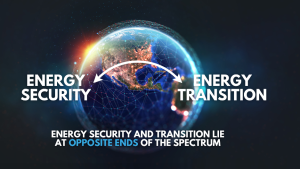
And under this current scenario, legacy energy providers are grappling with the financial risks of continued investments in their existing businesses while balancing legal, political, and social pressures. They are operating under excessive ambiguity.
On the other hand, promising new technologies including EVs, have prolonged challenges before they may be considered stable platforms: these vehicles remain relatively expensive, are vulnerable to immature supply chains, and their manufacturers are sourcing some of the most important raw materials from unstable and/or rival nations. And of course, the US power grid has its own storied history of problems.
So while we should embrace our future, we must also be candid in realizing that change (even positive change) and real-time energy security rarely see eye-to-eye.
As such, it is important we continue funding our ready-now solutions while also investing in future, aspiration ideas. As a country, it seems we have an awful time accepting an “all of the above” energy strategy—one that avoids overly simplistic either/or thinking. It’s as if the US is in a relay race and instead of passing the baton hand-to-hand, we are asking one sprinter to throw the baton 50 yards ahead to the next sprinter while moving at full speed. And thereby taking unnecessary transition risks.
Transportation’s Transformation
It is noteworthy, despite progress made since 1980 and unlike large-scale events of the past, today’s energy transition ideas are not rooted in a traditional economic model. Rather, this transition is motivated by a mixture of climate worry, often misinformed media, political power, extraordinary science, and free enterprise. I wonder if ever before, there have been so many powerful stakeholders, with so many competing priorities, sitting atop a single issue?
Long before it was fashionable, virtually all legacy energy manufacturers announced their commitment to pursue cleaner technologies while using existing infrastructure—that’s old news.
Today these same energy companies, having made enormous investments, are now realizing their long-term bets may be socially, economically, or even legally punished in the coming years. And as these for-profit businesses have employees & shareholders to consider, they are now prone to cut investments and lower their exposure for routine R&D, energy exploration as well as pipeline and refinery modernization. And considering what we know from our year 2050 EIA data, in my mind, we are watching a slow-motion national disaster unfold.
Against this backdrop, consumers are subject to more volatile price swings and periodic supply shortages. These events are not a cause leading to an energy transition; rather, they are a result of that push being unsupported by good planning. Without thoughtful regulatory clarity connected to an all-of-the-above planning approach that is focused on actual climate benefits, we risk stifling the creativity that has defined us as a nation.
Existing technology offers great benefits – policy should not over-focus on one solution.
As we work to remove the gap between cleaner energy and energy security, the petroleum industry has made significant progress. Today it manufactures products such as renewable diesel & sustainable aviation fuels, has pioneered carbon capture technologies, and has invented carbon-negative engine oils—products made of renewable and synthetic molecules. Interestingly, these here & now companies are disrupting the would-be disruptors by leading in energy security, affordability, and environmental benefit in real-time.
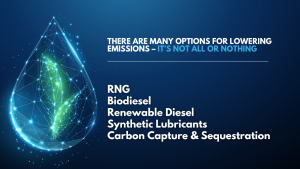
For example, thanks to remarkable miles/gallon engine technology, emissions control systems, selective catalytic reduction and more, the US is operating the cleanest fleet in history. In fact, a diesel engine powered by Renewable Diesel operates with a lower carbon footprint than does today’s EV—this according to the EPA’s sponsored GREET model.
This is a wonderful feat of chemistry & engineering and not a criticism of EVs. In fact, EVs are important and will only become more so over time. And while US GDP tripled since 1980, pollution emissions have been cut by more than half. In fact, today’s vehicles are 99% cleaner than their 1970 ancestors – nearly a complete decline of emissions such as NOx, carbon monoxide, and particulate emissions.
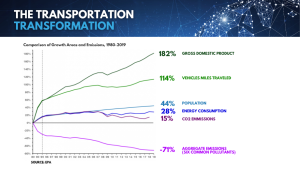
Yet there’s work to be done. Some areas of the country still face substandard local air quality, and the world at large must address our carbon challenge. But what has been accomplished is impressive on an industrial scale. And without an all-of-the-above strategy, we risk losing our momentum toward an even more clean, affordable, and secure energy future.
I hope we can keep this progress in mind while remembering our imperfect US energy supply chain is the envy of the world. And we should celebrate it.
Recommendations
In conclusion, we encourage policymakers to consider these three simple ideas.
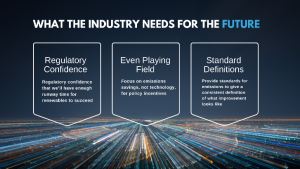
1. Provide Regulatory Confidence
Broadcast and encourage an all-of-the-above energy strategy– support both under-development and here-now technologies. By support, I don’t mean fund. I mean be encouraging. By doing so, our innovators can have the risk-taking confidence required to manage a decades-long journey of enormous complexity.
2. Apply a Level Playing Field
Our energy policies must focus on our carbon reduction goals while remaining technology agnostic. Our government should not be in the business of picking technology winners and losers but rather keep its eye on the carbon reduction prize—a prize of the highest stakes. By doing so, our regulators will encourage all stakeholders and risk-takers to participate in this grand adventure. And we unleash free enterprise to do what it does best—innovate in the most unbelievable ways.
3. Standardize Our Definitions
Adopt a common environmental language across the entire country. Today there exists a confusing patchwork of state & federal-level mixed messages that discourage scalable solutions & limit valuable collaboration. Let’s use one dictionary.
Conclusion
As we look forward, energy security and the energy transition need not be on opposite ends of the spectrum. We have already seen decades of progress in cleaning the environment, and the next years will bring even more breakthroughs. We just need some common-sense courage to guide us along. Certainly, the tax-paying public deserves nothing less.
This article is part of Uncategorized
MARKET CONDITION REPORT - DISCLAIMER
The information contained herein is derived from sources believed to be reliable; however, this information is not guaranteed as to its accuracy or completeness. Furthermore, no responsibility is assumed for use of this material and no express or implied warranties or guarantees are made. This material and any view or comment expressed herein are provided for informational purposes only and should not be construed in any way as an inducement or recommendation to buy or sell products, commodity futures or options contracts.






